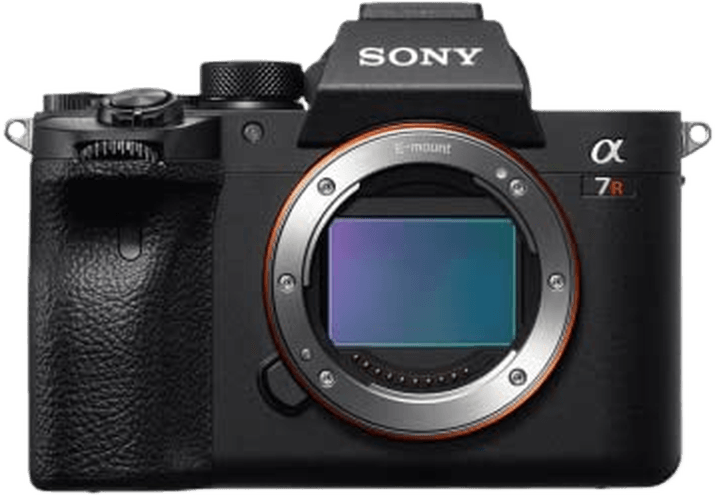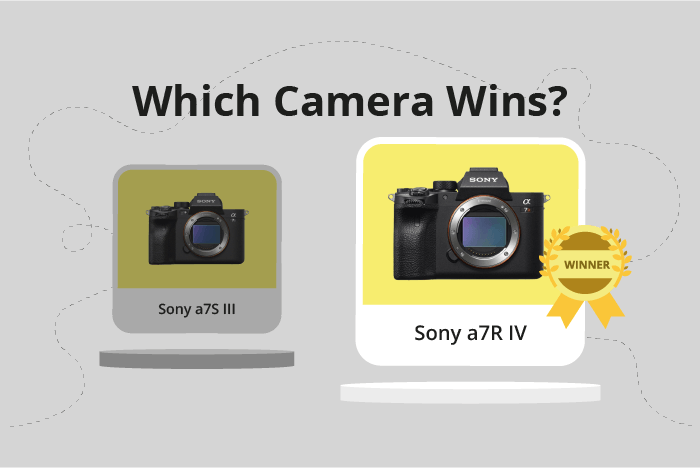Sony a7S III vs a7R IV Comparison
Sony a7S III

Sony a7R IV

The Sony a7R IV outperforms the Sony a7S III with a score of 84/100 compared to 74/100. Both cameras share similarities, such as being mirrorless and having similar dimensions, with the a7S III measuring 129 x 97 x 81mm and the a7R IV at 129 x 96 x 78mm. They also have comparable launch prices, with the a7S III at $3499 and the a7R IV at $3500.
The a7R IV surpasses the a7S III with its higher score, making it a superior camera. On the other hand, the a7S III has a slight advantage in terms of weight, weighing 699g compared to the a7R IV’s 665g. This difference might be beneficial for those who prefer a lighter camera.
Taking these points into consideration, the Sony a7R IV proves to be a better choice for photographers seeking higher performance. However, the Sony a7S III remains a viable option for those who prioritize a lighter weight.
Sony a7S III vs a7R IV Overview and Optics
The Sony a7R IV outperforms the Sony a7S III in optics with a score of 85/100 compared to the a7S III’s 69/100. Both cameras share several specifications, such as shooting speed (10 fps), sensor type (CMOS), sensor size (Full Frame), lens mount (Sony FE), and image stabilization.
The a7R IV’s superior optics stem from its higher megapixel count (61.2) and a better DXOMARK score for the sensor (99). The increased megapixel count allows the a7R IV to capture more detail and produce higher resolution images. The higher DXOMARK score indicates that the a7R IV has better overall image quality, dynamic range, and low-light performance. The a7R IV also uses a Bionz X processor, which contributes to its improved optics.
The a7S III, on the other hand, has a lower megapixel count (12.1) and a lower DXOMARK score for the sensor (86). However, it features a Bionz XR processor, which is faster and more efficient than the Bionz X processor in the a7R IV. This advantage allows the a7S III to process images quickly and possibly handle video better than the a7R IV.
To sum up, the Sony a7R IV is the better choice for photographers who prioritize high-resolution images and overall image quality. The higher megapixel count and DXOMARK score make it a superior option in terms of optics. The Sony a7S III, while not as strong in the optics department, has a faster processor that may benefit videographers and those who prioritize processing speed.
Sony a7S III vs a7R IV Video Performance
The Sony a7S III outperforms the Sony a7R IV in video capabilities with a video score of 77/100, compared to the a7R IV’s score of 70/100. Both cameras share some common specifications, such as a maximum video resolution of 4K and maximum video dimensions of 3840 x 2160. However, the a7S III surpasses the a7R IV in several aspects, making it the superior choice for videographers.
The a7S III boasts a higher maximum video frame rate of 120fps, which is four times faster than the a7R IV’s 30fps. This higher frame rate enables the a7S III to capture smoother and more detailed slow-motion footage, providing an advantage for those who require this feature in their work. Additionally, the a7S III’s higher video score signifies its overall better performance in video quality, features, and capabilities.
On the other hand, the a7R IV has a built-in time-lapse functionality, which the a7S III lacks. This feature allows the a7R IV to capture stunning time-lapse videos without the need for external accessories or software, making it a favorable choice for photographers who value this function.
To conclude, the Sony a7S III stands out as the better camera for video capabilities due to its higher video score, faster maximum video frame rate, and overall superior performance. However, the Sony a7R IV has its advantage with the built-in time-lapse functionality, catering to photographers who prioritize this feature. Ultimately, the choice between these cameras depends on the specific needs and preferences of the user.
Sony a7S III vs a7R IV Features and Benefits
The Sony a7S III and Sony a7R IV both receive a feature score of 83/100, indicating that they are equally matched in terms of their capabilities. They share several specifications, including a 3-inch screen size, 1,440,000-dot screen resolution, touchscreen functionality, flip screen, and the lack of GPS. Both cameras also offer WiFi and Bluetooth connectivity.
Despite the equal scores, the Sony a7S III excels in certain aspects. It is known for its exceptional low-light performance, making it ideal for photographers and videographers who often work in dimly lit environments. The a7S III also boasts a higher video resolution, providing more detail and clarity in video recordings.
On the other hand, the Sony a7R IV has its own advantages. It features a higher megapixel count, which results in more detailed images and greater flexibility in post-processing. This makes the a7R IV a better choice for photographers who prioritize image quality, especially those who print their work or need high-resolution images for commercial purposes.
When considering these differences, potential buyers should weigh their specific needs and preferences. The a7S III is better suited for low-light conditions and videography, while the a7R IV excels in image quality and resolution. Ultimately, both cameras are excellent choices, and the decision should be based on the individual’s requirements and priorities.
Sony a7S III vs a7R IV Storage and Battery
The Sony a7R IV wins in the storage and battery category with a score of 79/100, while the Sony a7S III scores 76/100. Both cameras have two memory card slots and accept SD/SDHC/SDXC (UHS-II compatible) cards. They also use the same NP-FZ100 battery type and offer USB charging.
The a7R IV outperforms the a7S III with a battery life of 670 shots, compared to the a7S III’s 600 shots. This difference allows the a7R IV users to capture more images before needing to recharge or replace the battery.
However, the a7S III has an advantage in memory card versatility, as it also supports CFexpress Type A cards in addition to SD/SDHC/SDXC cards. This feature provides users with more storage options and potentially faster data transfer rates.
Both cameras have their strengths in storage and battery performance. The a7R IV offers longer battery life, while the a7S III provides greater memory card compatibility. Users should consider their specific needs and preferences when choosing between these two cameras.
Alternatives to the Sony a7S III and a7R IV
Are you still undecided about which camera is right for you? Have a look at these popular comparisons that feature the Sony a7S III or the Sony a7R IV:

